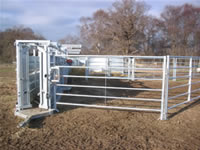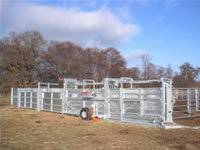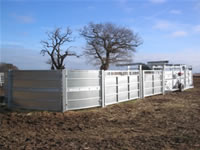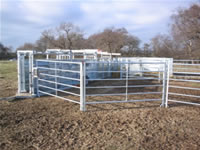Organisation:
Richard and Natasha Mann, Iken Hall Farms, Woodbridge. Suffolk
As well as growing potatoes and vegetables, Richard and Natasha Mann have the Yarn Hill herd of pedigree Lincoln Red beef cattle that are reared organically. The herd comprises around 80 head and they carry out most of the stock tasks themselves. At present they take the steers to 29 months and sell privately which is increasing year on year
Introduction
The Farm entered the HLS scheme 2 years ago and converted marsh wheat growing land into organic grassland. This meant an increase in herd size from 5 cows up to a planned maximum of 100 cows plus followers. Originally a makeshift handling system was put together with 6 gates and used to pen the animals needed but this was proving to be quite unsafe and inefficient. Even though reinforced with trailers it did not stop a bull jumping over them on one occasion!
During the summer months, the herd grazes on Marsh fields running down to the River Alde whilst winter months are spent on upland sandy fields close to the home farm near Woodbridge.
The business needed to find a solution to the handling problem that was cost effective, provided for high standards of animal welfare, was safe, easy to use and mobile.
What was done
Richard and Natasha chose a handling system, which could be moved and set up easily by themselves every six months. The crush, race and gates are essentially a mobile system. However, to improve the effectiveness they also use an additional circular forcing pen.
The equipment supplier helped by designing a curved stock holding pen and cattle race in which the animals naturally move towards the light from the open access beyond the cattle crush. By having curved, closed pen sides, animals cannot bruise themselves by being caught in angular areas.
The Yarn Hill herd have also benefitted from the central high-sided stockholding area providing a sheltered straw bed area for winter calving.
Permanent posts were set up at both sites enabling quick removal and assembly of the forcing pen. The cattle crush is moveable and self-contained with it's own wheeled axles and drawbar. Dismantling the system, loading, unloading and reassembling it at the other site takes 2 people 8 hours.
Setting up the posts at both sites involved digging holes and concreting them in. This took about 2days of farm labour per site; a concrete pad was also laid at each site to make things more permanent.
The cost of the system including circular forcing pen and additional posts was approximately £22000. The handling system qualified for some capital grant aid which meant it could be set up properly and make it was as labour efficient as possible.
Business benefits
The system itself provides high standards of welfare for the animals which is an important consideration for customers of this business.
The most significant advantage is that when the cattle are located at either site there is a readily available handling system. It is easily operated by one person keeping labour requirements to a minimum for routine handling tasks.
Health and safety benefits
Natasha comments that the system works really well, providing a safe environment for both her and her Lincoln Red Herd. If she has to inject or handle a few stock by herself the cattle handling system allows her to work competently on her own.
Further information
This is a good example of a solution for beef farms with different sites where grazing land is some distance from the main holding or winter housing. The semi-permanent installation used here works well for a couple of sites.


The crush can be readily wheeled into place.

